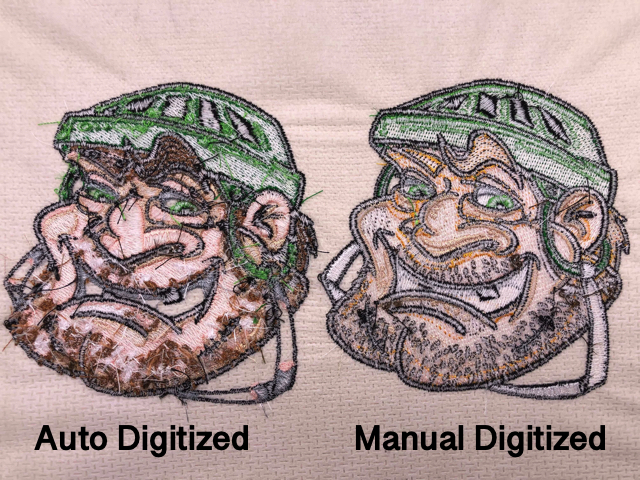Check Out Different Sorts Of Needlework Digitizing Methods
Embroidery digitizing has progressed dramatically over the years, offering a myriad of techniques to bring styles to life in the electronic realm. The realm expands to extra innovative strategies like photorealistic needlework digitizing and the remarkable world of 3D needlework digitizing.
Typical Hand Needlework Digitizing
Conventional hand embroidery digitizing includes the process of converting intricate hand-stitched designs right into electronic layouts for equipment needlework. This strategy needs skilled craftsmens to diligently assess the handmade layout and after that make use of specialized software program to recreate it in an electronic style. Each stitch, shade, and information needs to be meticulously equated to ensure that the significance of the initial hand embroidery is maintained in the electronic version.
Among the vital difficulties of conventional hand needlework digitizing is catching the complexities and nuances of the handmade layout. Digitizing for Embroidery. Craftsmens must have a deep understanding of different embroidery strategies, such as satin stitch, chain stitch, and French knots, to precisely replicate these strategies in the digital realm. In addition, they require to have a keen eye for information to make certain that the electronic style preserves the exact same level of creativity and craftsmanship as the initial hand-stitched item
Punching Strategy
To seamlessly change from traditional hand embroidery digitizing to the punching strategy, craftsmens must currently concentrate on converting the elaborate digital layouts into directions that needlework equipments can analyze. The boxing strategy entails making use of specialized software program to develop digital files that include commands for the needlework maker to follow. This procedure requires a deep understanding of not just the layout itself yet likewise the capabilities and restrictions of the embroidery machine.

Auto-Digitizing Software Application Programs
Embroidery digitizing has been reinvented by the advent of auto-digitizing software programs, offering craftsmens with advanced devices to transform digital layouts into embroidery equipment guidelines effectively. Auto-digitizing software application use formulas to analyze electronic pictures or vector data see here and create needlework layouts instantly. These programs permit fast and precise conversion of elaborate designs right into stitch patterns, conserving effort and time for embroiderers.
One of the crucial advantages of auto-digitizing software is its easy to use interface, making it accessible to both beginners and experienced digitizers. These programs typically consist of attributes such as stitch editing and enhancing tools, thread color matching, and the capacity to sneak peek the last stitched style. Furthermore, auto-digitizing software can handle complex layouts with several shades and complex information, creating top notch embroidery files suitable for different clothing and textile projects.
While auto-digitizing software provides benefit and effectiveness, it is important for users to comprehend the limitations of automated digitizing. Fine-tuning and hands-on adjustments might still be required to attain the desired needlework quality, specifically when handling intricate or one-of-a-kind styles. By leveraging the abilities of auto-digitizing software along with hands-on digitizing techniques, artisans can improve their embroidery digitizing procedure and create stunning stitched pieces.
Photorealistic Embroidery Digitizing
Making use of sophisticated electronic imaging methods, achieving photorealistic outcomes in embroidery digitizing has become a desired skill amongst contemporary artisans. This strategy includes converting high-resolution images right into complex stitch patterns that carefully imitate the original layout, leading to needlework pieces that exhibit natural detail and deepness.
To achieve photorealistic needlework digitizing, artisans must have an eager eye for information and a complete understanding of how different stitch types and densities can impact the last end result. By thoroughly drawing up each shade and color in the image, embroiderers can produce a digital documents that overviews the embroidery device to duplicate the subtleties of the initial picture accurately.
Photorealistic needlework digitizing is especially prominent in producing personalized designs for clothing, home decoration, and art items where catching the significance of a picture or art work is critical. This technique enables artisans to change memories, landscapes, pictures, and detailed art work into sensational stitched work of arts that showcase a mix of typical workmanship Learn More Here and sophisticated modern technology.
3D Needlework Digitizing
With the improvement of digital imaging methods in achieving photorealistic lead to get more needlework digitizing, the expedition of 'D Embroidery Digitizing' offers a brand-new measurement to the complexities of design replication. 'D Needlework Digitizing' refers to the three-dimensional digitizing technique that adds deepness and structure to needlework layouts, creating a much more reasonable and visually appealing final product. This technique makes use of software that simulates the result of light and shadow on the needlework style, enhancing its general aesthetic impact.
Among the essential advantages of 'D Embroidery Digitizing' is its ability to make styles look more realistic and dynamic. By including depth to the needlework design, the last product shows up more practical and fascinating (Digitizing for Embroidery). In addition, this method enables more imaginative flexibility in layout execution, making it possible for embroiderers to try out various textures and results that were previously challenging to attain
Final Thought
